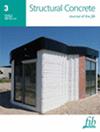钢-玻璃纤维增强混凝土混合板弯曲行为的实验、理论和数值研究
IF 3.3
3区 工程技术
Q2 CONSTRUCTION & BUILDING TECHNOLOGY
引用次数: 0
摘要
本文介绍了六种全尺寸单向钢筋混凝土板的试验结果,这些板的钢筋细部设计各不相同。试验试件包括两块完全用玻璃纤维增强聚合物(GFRP)钢筋或钢筋加固的参考混凝土板和四块混合加固板。变量包括钢筋排列、机械配筋率以及钢筋面积与玻璃纤维增强聚合物钢筋面积之比。制作好的试样在强楼板实验室中承受四点加载直至破坏。实验结果表明,与玻璃钢加固相比,混合加固增强了刚度,并提供了比钢筋更高的承载能力。此外,还观察到作为拉伸钢筋放置的玻璃钢钢筋,其数量和直径大小与作为压缩钢筋放置在楼板中的钢筋相似,因此极限承载力最高。此外,研究还发现,虽然机械配筋率对混合加固混凝土楼板的整体性能有影响,但钢筋面积与玻璃纤维增强塑料钢筋面积之比效果并不显著。此外,还采用了图像处理技术来确定试样破坏后的确切裂缝宽度。最后,有限元建模结果与实验结果显示出良好的一致性。本文章由计算机程序翻译,如有差异,请以英文原文为准。
Experimental, theoretical and numerical study on flexural behavior of hybrid steel‐GFRP reinforced concrete slabs
This paper presents the experimental results of six full‐scale one‐way reinforced concrete slabs with variations in reinforcement detailing. Test specimens consisted of two reference concrete slabs reinforced fully with glass fiber reinforced polymer (GFRP) rebars or with steel rebars and four hybrid‐reinforced slabs. The variables included the arrangement of rebars, mechanical reinforcing ratio, and the ratio of steel rebar area to GFRP rebar area. The fabricated specimens were subjected to four‐point loading until failure in the strong floor laboratory. Experimental results indicated that hybrid reinforcement enhances stiffness compared to FRP reinforcement and provides a higher load‐bearing capacity than steel reinforcement. Also, it was observed that FRP bars placed as tensile reinforcement, similar in number and diameter size to steel bars placed as compressive reinforcement in a slab result in the highest ultimate capacity. Moreover, it was observed that while the mechanical reinforcing ratio contributes to the overall behavior of hybrid‐reinforced concrete slabs, the ratio of steel rebar area to GFRP rebar area is not considerably effective. Furthermore, image processing was employed to determine the exact crack widths of specimens after failure. Finally, finite element modeling results showed good agreement with the experimental results.
求助全文
通过发布文献求助,成功后即可免费获取论文全文。
去求助
来源期刊

Structural Concrete
CONSTRUCTION & BUILDING TECHNOLOGY-ENGINEERING, CIVIL
CiteScore
5.60
自引率
15.60%
发文量
284
审稿时长
3 months
期刊介绍:
Structural Concrete, the official journal of the fib, provides conceptual and procedural guidance in the field of concrete construction, and features peer-reviewed papers, keynote research and industry news covering all aspects of the design, construction, performance in service and demolition of concrete structures.
Main topics:
design, construction, performance in service, conservation (assessment, maintenance, strengthening) and demolition of concrete structures
research about the behaviour of concrete structures
development of design methods
fib Model Code
sustainability of concrete structures.
 求助内容:
求助内容: 应助结果提醒方式:
应助结果提醒方式:


